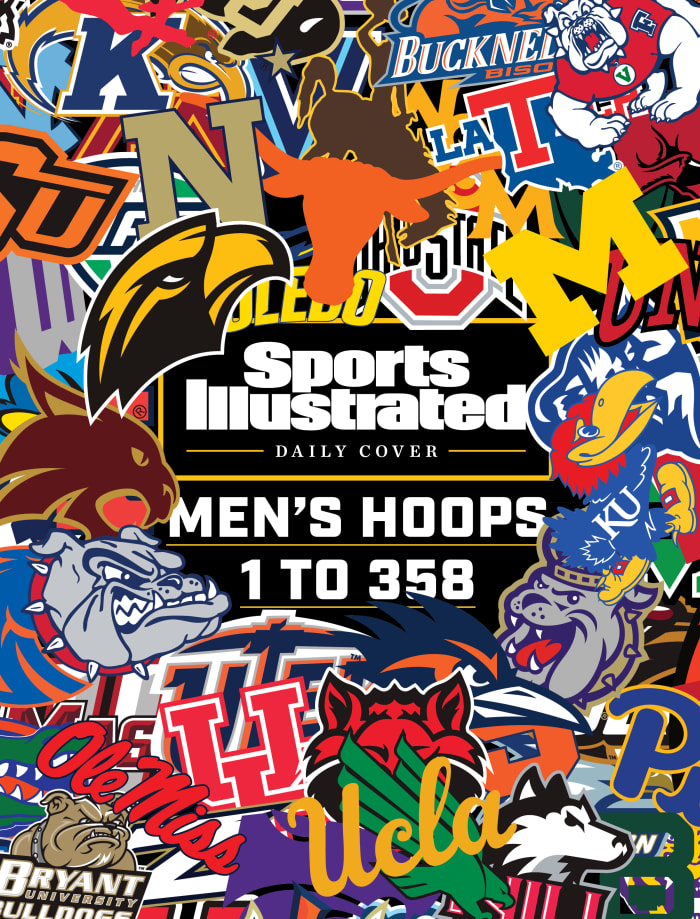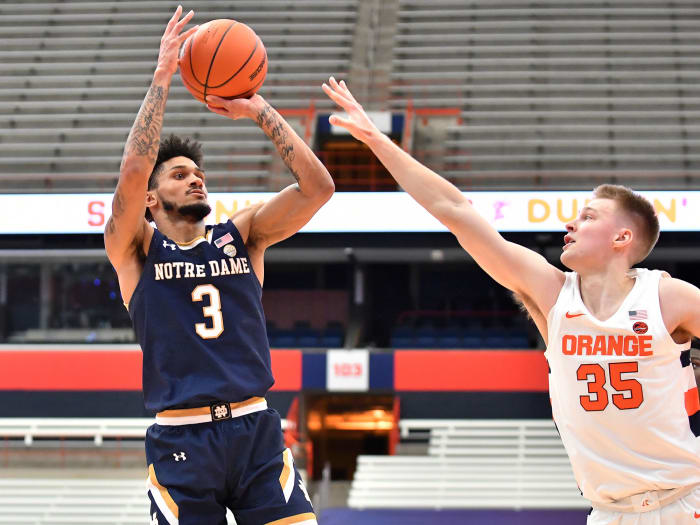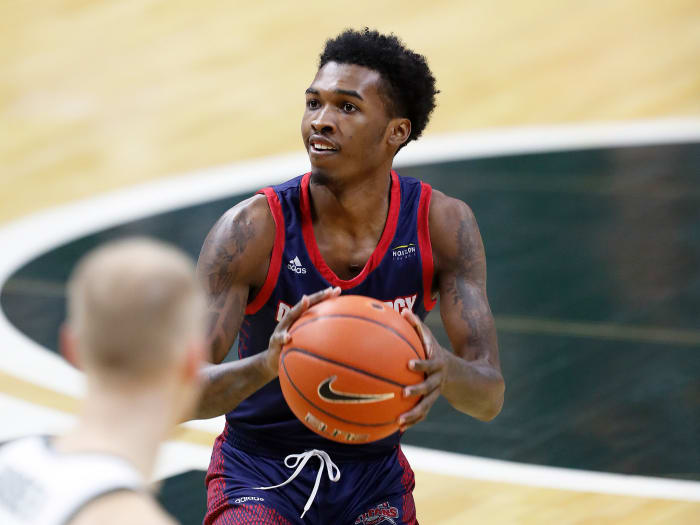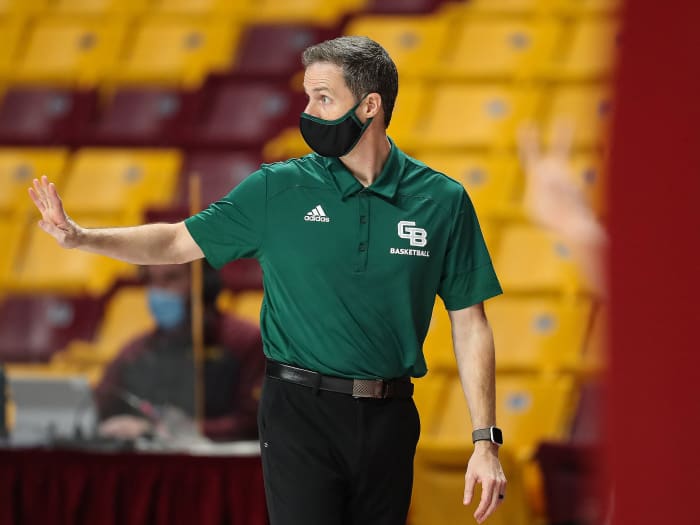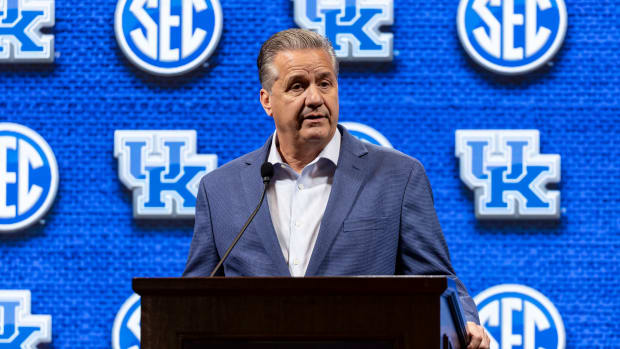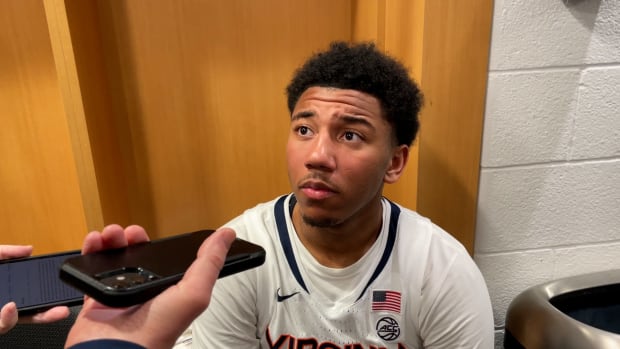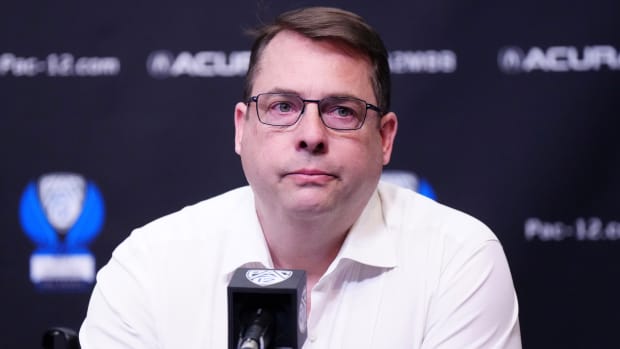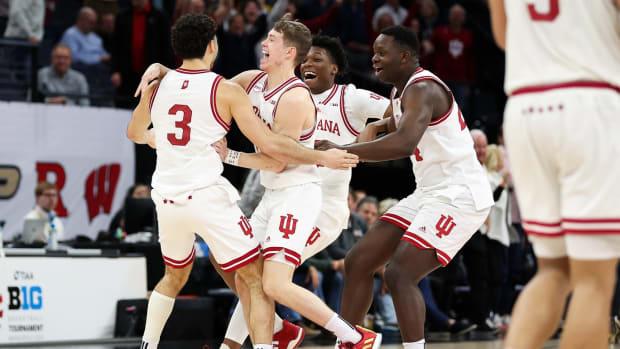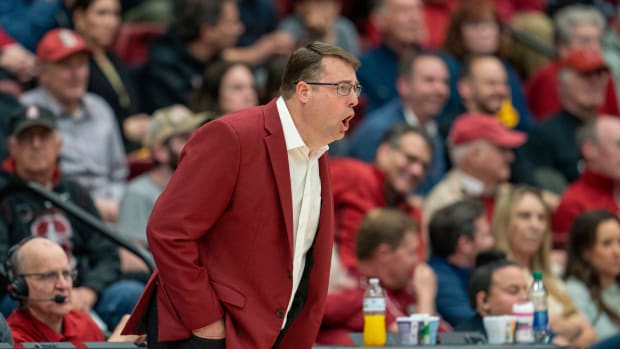The 2021–22 college basketball season begins next week, and after a one-year hiatus, Sports Illustrated’s annual preseason ranking of every men’s Division I team is back.
College hoops often feels all-encompassing—it’s not uncommon to see the sport’s elite teams host even the weakest D-I competition in nonconference play, and every March, programs that the average fan knows nothing about get their chance on the biggest stage. It can be overwhelming to look at the sheer number of D-I teams (currently 358) and sort through expectations.
That’s why we’re here. This year’s 1–358 ranking was put together by SI college basketball writer Kevin Sweeney, who set out on the task of weighing the placement of every program in the country. Some of the rankings of all 358 teams out there are analytical or built with an algorithm. This one isn’t that, but several factors were considered: returning production (and projected growth for those players), transfer additions, recruiting gains, program and coach reputation, conference strength and more. The hope was to capture a snapshot of preseason expectations, from the Power 5 down to the low mid-majors.
Below are the results, plus insights and information from Sweeney and editor Molly Geary on the SI preseason top 25 and dozens of other notable teams, all the way down to No. 358. And for conference ratings based on the national ranking, click here.
1. Gonzaga (1st in WCC): Dominant post scorer Drew Timme and uber-skilled 7' 1" freshman Chet Holmgren will be the nation’s best frontcourt tandem. Add senior point guard Andrew Nembhard, and Mark Few’s Bulldogs should spend much of the year atop the polls—as they did last season.
2. Texas (1st in Big 12): New coach Chris Beard revamped the roster through the transfer portal, bringing in guards Marcus Carr (Minnesota) and Devin Askew (Kentucky); and forwards Timmy Allen (Utah), Dylan Disu (Vanderbilt), Christian Bishop (Creighton) and Tre Mitchell (UMass). Now comes the hard part: making everything fit.
3. Kansas (2nd in Big 12): Four starters return, including 6’ 5” Ochai Agbaji and 6’ 8” Jalen Wilson, who are NBA prospects. Bill Self also addressed the Jayhawks’ glaring need for a dynamic ballhandler, landing 6-foot Arizona State transfer Remy Martin.
4. UCLA (1st in Pac-12): Last year the Bruins became just the second team to advance from the First Four to the Final Four, but this time around their tournament footing should be more solid, thanks to the arrival of 6’ 10” Myles Johnson (Rutgers) and five-star small forward Peyton Watson.
5. Michigan (1st in Big Ten): The return of All-American center Hunter Dickinson should be enough to keep the Wolverines among the elite. But they also have SI’s No. 1 recruiting class and 6’ 1” point guard DeVante’ Jones, a transfer from Coastal Carolina.
6. Memphis (1st in AAC): College basketball’s most interesting coaching staff (Penny Hardaway and assistants Rasheed Wallace and Larry Brown) will oversee a wildly talented roster led by 6’ 9” freshman playmaker (and former SI cover star) Emoni Bates.
7. Baylor (3rd in Big 12): The defending champions lost four starters but still have the pieces to make a strong March run, including wing Matthew Mayer (39.5% from three) and 6’ 1” guard James Akinjo, who led Arizona in scoring last year (15.6 ppg).
8. Purdue (2nd in Big Ten): The Boilermakers have two of the nation’s best bigs (6’ 10” Trevion Williams and 7’ 4” Zach Edey) and an exciting guard in 6’ 4” Jaden Ivey—a makeup similar to the Purdue team that made the Elite Eight in 2019.
9. Kentucky (1st in SEC): After the Wildcats’ worst season (9–16) since 1926–27, John Calipari picks up experience and shooting from the transfer portal and, as usual, a trio of high-end high school talents.
10. Villanova (1st in Big East): No top team benefited more from the NCAA’s ruling to give players an extra year of eligibility due to COVID-19. The Wildcats get back star point guard Collin Gillespie and versatile 6’ 7” forward Jermaine Samuels.
11. Duke (1st in ACC): The Blue Devils have enough talent to give the soon-to-be-retired Mike Krzyzewski a memorable sendoff. Potential No. 1 NBA pick Paolo Banchero, a 6’ 10”, 250-pound forward, is more polished than any newcomer in the nation. And 7-footer Mark Williams, who shot 66.4% last year, is poised to break out as a sophomore.
12. Oregon (2nd in Pac-12): Few teams have the Ducks’ combination of depth, experience and talent in the backcourt. Syracuse transfer Quincy Guerrier will thrive as a playmaking big in their spread offense.
13. Houston (2nd in AAC): Kelvin Sampson has built a program with staying power, so the Cougars will remain relevant despite losing three starters from a Final Four team. Guards Kyler Edwards and Marcus Sasser will score, and any Sampson-led team will defend and rebound well.
14. North Carolina (2nd in ACC): The Tar Heels certainly seem well-positioned to win big in Hubert Davis’s first year at the helm. Transfers Dawson Garcia (Marquette) and Brady Manek (Oklahoma) form a versatile big-man trio with 6’ 10” junior Armando Bacot.
15. Alabama (2nd in SEC): It was a breakthrough second season for Nate Oats, whose upbeat attack took off thanks to a deep stable of guards—to which he will add five-star recruit and electric leaper JD Davison.
16. Illinois (3rd in Big Ten): Kofi Cockburn’s surprise return gives the Illini as good a piece to build around as any in the country. The 7-foot, 285-pound junior averaged 17.7 points and 9.5 rebounds last season and pulled out of the draft to return to Champaign.
17. Arkansas (3rd in SEC): Eric Musselman clearly has this program on an upward trajectory, and a pair of versatile 6’ 6” transfers, Stanley Umude (South Dakota) and Au’Diese Toney (Pittsburgh), are perfect fits in his positionless system.
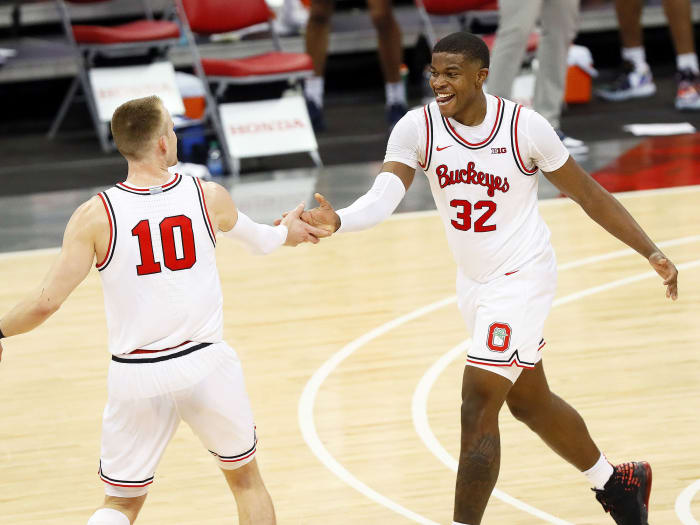
Justin Ahrens (left) and E.J. Liddell are both back for Ohio State.
Kyle Robertson/Columbus Dispatch/USA TODAY Network
18. Ohio State (4th in Big Ten): The Buckeyes have finished in the top 16 of KenPom’s final rankings in three of four years under Chris Holtmann, but have never made the Sweet 16. E.J. Liddell, a 6’ 7” forward who averaged 16.2 points and a team-high 6.7 rebounds per game last season, could help change that.
19. Indiana (5th in Big Ten): Excitement is high for the dawn of the Mike Woodson era. Led by 6’9” junior forward Trayce Jackson-Davis, the Hoosiers looked impressive during an August trip to the Bahamas, where they played a Serbian pro team.
20. Tennessee (4th in SEC): Five-star point guard Kennedy Chandler and 6’ 6” Auburn transfer Justin Powell, who had a pair of 26-point games before missing most of the season in concussion protocol, form a dangerous backcourt for Rick Barnes.
PREVIEWS: American | ACC | Big 12 | Big East
21. Florida State (3rd in ACC): The Seminoles are consistently dangerous under Leonard Hamilton. While the coach lost some important pieces, Houston transfer Caleb Mills, senior Anthony Polite and a top-10 recruiting class should continue that tradition.
22. UConn (2nd in Big East): James Bouknight is gone, but a trio of upperclassmen (R.J. Cole, Tyrese Martin, Isaiah Whaley), promising sophomore big Adama Sanogo and the return of a healthy Akok Akok make this versatile group one to watch.
23. St. Bonaventure (1st in Atlantic 10): The Bonnies had five double-digit scorers last season and bring back all of them—as seniors. One of them, point guard Kyle Lofton, played a higher percentage of minutes (96%) than anyone in the country in 2020–21.
24. Maryland (6th in Big Ten): Mark Turgeon brought in Fatts Russell (Rhode Island) and Qudus Wahab (Georgetown) to shore up key holes at point guard and center, respectively. Together with returners Eric Ayala and Donta Scott, the Terps have a talented and experienced core.
25. Oklahoma State (4th in Big 12): If you thought the Cowboys would fade away now that Cade Cunningham has moved on, think again. Point guard Avery Anderson III looks poised to take the reins as leading scorer, and a young group that jelled down the stretch will look to hold its own.
26. Texas Tech (5th in Big 12)
27. Auburn (5th in SEC)
28. Seton Hall (3rd in Big East)
29. Arizona (3rd in Pac-12)
30. Xavier (4th in Big East)
Mark Adams, the new head coach at Texas Tech (No. 26), is a West Texas guy through and through. His patented no-middle defense and a talented crop of transfers give the Red Raiders a chance to climb the Big 12 ladder. The ceiling of Auburn (No. 27) is defined by the health of star wing Allen Flanigan, who’ll miss the start of the season due to an Achilles injury. Kevin Willard has the pieces for a potentially elite defense at Seton Hall (No. 28), while a pair of transfer guards in Kadary Richmond and Jamir Harris bring huge upside. Arizona (No. 29) features a new head coach in Tommy Lloyd, who was Mark Few’s right-hand man in building a dynasty at Gonzaga. And it’s a must-win year for Travis Steele at Xavier (No. 30), which is in its longest men’s NCAA tournament drought since the early 1980s.
31. Virginia (4th in ACC)
32. Loyola Chicago (1st in Missouri Valley)
33. Michigan State (7th in Big Ten)
34. Virginia Tech (5th in ACC)
35. BYU (2nd in WCC)
36. San Diego State (1st in Mountain West)
37. USC (4th in Pac-12)
38. Florida (6th in SEC)
39. West Virginia (6th in Big 12)
40. Colorado State (2nd in Mountain West)
41. Rutgers (8th in Big Ten)
42. LSU (7th in SEC)
43. St. John's (5th in Big East)
44. Wichita State (3rd in AAC)
45. Louisville (6th in ACC)
46. Richmond (2nd in A-10)
47. Oklahoma (7th in Big 12)
48. Mississippi State (8th in SEC)
49. Syracuse (7th in ACC)
50. UAB (1st in C-USA)
Tony Bennett remade his roster at Virginia (No. 31) and will need big things out of senior Kihei Clark, East Carolina transfer Jayden Gardner and sophomore Reece Beekman if the Cavs are to overachieve. Porter Moser left for the job in Norman, but don’t expect Loyola Chicago (No. 32) to go anywhere—particularly with super senior and defensive stalwart Lucas Williamson leading the way. The vibes out of East Lansing seem positive, raising optimism that Tom Izzo’s Michigan State (No. 33) team will rebound after nearly missing the NCAA tournament. Keep an eye out for touted freshman guard Max Christie.
San Diego State (No. 36) and Colorado State (No. 40) are the strongest contenders to make the Mountain West a two-bid league for the fourth straight March Madness. The Rams haven’t danced since 2013, but they return almost everyone from a team that reached the NIT semifinals. Last March, Rutgers (No. 41) broke the program’s long tourney drought and even won a game there, and could dance again despite losing three key rotation pieces. LSU’s (No. 42) depth took a hit when it was recently announced Illinois transfer Adam Miller tore his ACL, dropping the Tigers several spots in our rankings.
Don’t sleep on Richmond (No. 46), which brought back everyone except leading scorer Blake Francis and will once again be one of the nation’s most veteran teams. Moser has a new home at Oklahoma (No. 47), where he brought in brothers (and first-round NCAA tourney standouts) Tanner and Jacob Groves to join Umoja Gibson and Elijah Harkless. Buddy Boeheim is back to get more buckets at Syracuse (No. 49), and his brother Jimmy transferred in from Cornell (as did Cole Swider, from Villanova). UAB (No. 50) could be the class of Conference USA behind a deep group of high-major transfers.
51. Washington State (5th in Pac-12)
52. Wisconsin (9th in Big Ten)
53. Drake (2nd in MVC)
54. Nevada (3rd in Mountain West)
55. Miami (8th in ACC)
56. Notre Dame (9th in ACC)
57. Belmont (1st in Ohio Valley)
58. Arizona State (6th in Pac-12)
59. Providence (6th in Big East)
60. SMU (4th in AAC)
61. NC State (10th in ACC)
62. Butler (7th in Big East)
63. Iowa (10th in Big Ten)
64. Ole Miss (9th in SEC)
65. Saint Mary's (3rd in WCC)
66. TCU (8th in Big 12)
67. Dayton (3rd in A-10)
68. Western Kentucky (2nd in C-USA)
69. Creighton (8th in Big East)
70. San Francisco (4th in WCC)
71. Northwestern (11th in Big Ten)
72. Colorado (7th in Pac-12)
73. Missouri State (3rd in MVC)
74. Texas A&M (10th in SEC)
75. Stanford (8th in Pac-12)
Few, if any, teams in college basketball are older than Drake (No. 53), which will start two sixth-years, two fifth-years and a fourth-year who helped lead last year’s Bulldogs to the NCAA tournament. Miami (No. 55) and Notre Dame (No. 56) are hard to crack in the ACC: Both have significant issues on the defensive end, but are experienced and have great guards in Isaiah Wong and Prentiss Hubb, respectively.
In the Big East, Providence (No. 59) and Butler (No. 62) will define how deep the league is in 2021–22. Each has reasons for optimism: Providence brings back one of the best scoring big men in the country in Nate Watson, while Butler’s young core, led by Chuck Harris, was feisty at home a season ago and should be much improved. We’ll see if either has the talent to snag an at-large bid. If you prefer a transfer-heavy team, take a look at TCU (No. 66)—eight of 12 scholarship players are D-I transfers, including star forward Emanuel Miller.
A couple of mid-majors with significant upside worth mentioning are Dayton (No. 67) and San Francisco (No. 70). The Flyers are young but talented, with transfers Toumani Camara (Georgia) and Kobe Elvis (DePaul) expected to make a significant impact. San Francisco knocked off Virginia early last season before fading late, and optimism is high that the return of star guard Jamaree Bouyea combined with a bolstered frontcourt will produce a special season for the Dons.
Keep an eye on Northwestern (No. 71). Chris Collins’s seat has warmed while a young core has taken its lumps in Big Ten play, but there’s hope in Evanston for a breakthrough year with a now-veteran group. Stanford (No. 75) is still seeking its first trip to the Big Dance since 2014. It looks somewhat unlikely to change that in March, but senior Jaiden Delaire and a top-25 recruiting class led by Harrison Ingram are pieces to build around.
PREVIEWS: Big Ten | Pac-12 | SEC | Best of Rest
76. Northern Iowa (4th in MVC)
77. Georgia Tech (11th in ACC)
78. Louisiana Tech (3rd in C-USA)
79. Loyola Marymount (5th in WCC)
80. Marquette (9th in Big East)
81. Cincinnati (5th in AAC)
82. Kansas State (9th in Big 12)
83. VCU (4th in A-10)
84. Buffalo (1st in MAC)
85. Penn State (12th in Big Ten)
86. UCF (6th in AAC)
87. Iona (1st in MAAC)
88. Nebraska (13th in Big Ten)
89. Vanderbilt (11th in SEC)
90. Clemson (12th in ACC)
91. Boise State (4th in Mountain West)
92. Oregon State (9th in Pac-12)
93. Davidson (5th in A-10)
94. North Texas (4th in C-USA)
95. Saint Louis (6th in A-10)
96. New Mexico State (1st in WAC)
97. Missouri (12th in SEC)
98. Ohio (2nd in MAC)
99. Utah (10th in Pac-12)
100. Toledo (3rd in MAC)
Star guard AJ Green is healthy after missing most of last season with a hip injury, a huge boon for Northern Iowa (No. 76) and its hopes of competing atop the MVC. Coming off an ACC tournament title, Georgia Tech (No. 77) could slide down the standings after a pair of major departures but has a potential star senior in Michael Devoe. Loyola Marymount (No. 79), led by senior Eli Scott, should be a handful on offense, particularly if it can assuage its typical turnover woes.
The Shaka Smart era opens at Marquette (No. 80), but it could be a bumpy Year 1 after significant roster turnover. Buffalo (No. 84) and its breakneck pace are back, and an offensive-glass-crashing veteran group has it poised to top the MAC. The Rick Pitino era at Iona (No. 87) began with an NCAA tournament appearance (the program’s fifth straight) despite COVID-19 challenges, and the Gaels are our favorite in the MAAC to get there yet again.
Recent conference bottom-dwellers Nebraska (No. 88) and Vanderbilt (No. 89) could take incremental steps forward this year. The Cornhuskers add the first five-star in program history, Bryce McGowens, while Scotty Pippen Jr. is in line to again be among the nation’s top scorers for the Commodores, who add proven 7-footer Liam Robbins. Davidson (No. 93), Ohio (No. 98) and Toledo (No. 100) can commiserate over losing their top scorers off top-40 KenPom offenses, but the Bobcats and Rockets should remain competitive in the MAC. Bob McKillop’s Wildcats face a more uphill climb in the A-10 even as sharpshooting junior Hyunjung Lee moves into a lead role.
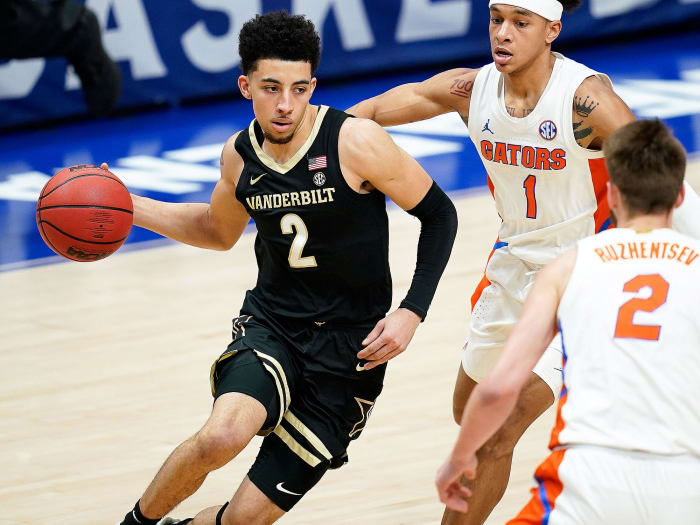
Scotty Pippen Jr. is likely to be among the nation's top scorers.
Andrew Nelles/Tennessean.com/USA TODAY Network
101. Wake Forest (13th in ACC)
102. Wright State (1st in Horizon)
103. Louisiana (1st in Sun Belt)
104. South Carolina (13th in SEC)
105. Washington (11th in Pac-12)
106. Utah State (5th in Mountain West)
107. George Mason (7th in A-10)
108. Iowa State (10th in Big 12)
109. Colgate (1st in Patriot)
110. Liberty (1st in A-Sun)
111. Pittsburgh (14th in ACC)
112. Tulsa (7th in AAC)
113. Morehead State (2nd in Ohio Valley)
114. South Dakota State (1st in Summit)
115. Chattanooga (1st in SoCon)
116. Georgia State (2nd in Sun Belt)
117. Georgetown (10th in Big East)
118. Rhode Island (8th in A-10)
119. Stephen F. Austin (2nd in WAC)
120. Southern Utah (1st in Big Sky)
121. Fresno State (6th in Mountain West)
122. DePaul (11th in Big East)
123. Stony Brook (1st in America East)
124. Cleveland State (2nd in Horizon)
125. Oral Roberts (2nd in Summit)
Plenty of high-major coaches would love to have Louisiana’s (No. 103) frontcourt, which features shot-blocking extraordinaire Theo Akwuba and former five-star Jordan Brown. Washington (No. 105) hopes a roster loaded with local ties can exceed expectations, otherwise Mike Hopkins’s seat will heat up quickly. New coach Kim English has breathed life into George Mason (No. 107), and he inherited quite the building block in star big Josh Oduro. The Patriots could be sneaky in the A-10.
Few teams came out of nowhere in 2020–21 more than Morehead State (No. 113), which rode star freshman big Johni Broome to an NCAA tournament bid. They won’t sneak up on anyone this season. Silvio De Sousa (of chair-brandishing fame) resurfaces at Chattanooga (No. 115), and the former elite recruit might just be the missing piece for a talented Mocs team. One major beneficiary of players getting an extra year of eligibility was Stephen F. Austin (No. 119), which brought back three double-figure scorers for one more season after the team was ineligible for the postseason in 2021. It’s one of four former Southland schools moving to the WAC and should be a worthy rival for New Mexico State at the top of the league.
Let’s give Todd Simon and Southern Utah (No. 120) their flowers. Simon has brought the Thunderbirds from six wins the year before he arrived to 20 a season ago—and the potential for even more in 2021–22. Elijah Olaniyi is executing what we’ll call a “boomerang transfer” back to Stony Brook (No. 123) after spending a year at Miami. He’ll be one of the America East’s best players. And of course, any fans of the sport are familiar with Oral Roberts (No. 125) and Max Abmas, the overwhelming favorite to lead the nation in scoring as a junior. Abmas won’t have running mate Kevin Obanor alongside him this year after Obanor departed for Texas Tech this offseason.
126. Grand Canyon (3rd in WAC)
127. UC Irvine (1st in Big West)
128. Furman (2nd in SoCon)
129. Temple (8th in AAC)
130. Kent State (4th in MAC)
131. Valparaiso (5th in MVC)
132. Murray State (3rd in Ohio Valley)
133. Vermont (2nd in A-East)
134. San Diego (6th in WCC)
135. UMass (9th in A-10)
136. Charlotte (5th in C-USA)
137. UC Santa Barbara (2nd in Big West)
138. Yale (1st in Ivy)
139. UNLV (7th in Mountain West)
140. Southern Illinois (6th in MVC)
141. Minnesota (14th in Big Ten)
142. Santa Clara (7th in WCC)
143. East Tennessee State (3rd in SoCon)
144. Bradley (7th in MVC)
145. Akron (5th in MAC)
146. Old Dominion (6th in C-USA)
147. James Madison (1st in CAA)
148. Winthrop (1st in Big South)
149. Weber State (2nd in Big Sky)
150. Eastern Kentucky (2nd in A-Sun)
After reaching its first D-I NCAA tournament, Grand Canyon (No. 126) loses its top two players and will need to recalibrate with point guard Jovan Blacksher Jr. and a number of transfers, including ASU’s Holland Woods II and Taeshon Cherry. UC Irvine (No. 127) is consistently a threat in the Big West under Russell Turner, and with skilled forward Collin Welp back, that will remain the case. Over at Valparaiso (No. 131), a quartet of names Big Ten fans may recognize (Wisconsin’s Kobe King, Trevor Anderson and Joe Hedstrom; Michigan State’s Thomas Kithier) will look to help push the newly renamed Beacons forward.
Vermont (No. 133) is home to the last five men’s America East Player of the Year winners, and could make it six as the most recent honoree, Ryan Davis, returns for his senior season. UC Santa Barbara (No. 137) brings back four starters from its NCAA tournament team and will push Irvine in the Big West even without JaQuori McLaughlin. The Ivy League is back after a one-year pandemic absence with Yale (No. 138) as its favorite. The Bulldogs are led by senior guard Azar Swain, who has 201 career threes. It could be a very long Year 1 for Ben Johnson at Minnesota (No. 141). Almost an entirely new roster arrives, one that’s mostly unproven at the high-major level.
James Madison (No. 147) and Winthrop (No. 148) are both projected SI conference winners; the Dukes took a big step forward last year after being among the nation’s worst teams in 2019–20 but are replacing CAA Player of the Year Matt Lewis, and the Eagles lose do-it-all star Chandler Vaudrin—not to mention coach Pat Kelsey—from a 23–2 campaign. Winthrop does retain a solid core, and new coach Mark Prosser brought Western Carolina’s Cory Hightower and Sin’Cere McMahon with him. Former Utah State/Marquette guard Koby McEwen has come back to his home state to finish his career at Weber State (No. 149), which could ride another strong shooting team to Big Sky contention.
151. UTEP (7th in C-USA)
152. Georgia (14th in SEC)
153. UC Riverside (3rd in Big West)
154. Boston College (15th in ACC)
155. Marshall (8th in C-USA)
156. Wofford (4th in SoCon)
157. South Florida (9th in AAC)
158. Duquesne (10th in A-10)
159. Hofstra (2nd in CAA)
160. Detroit Mercy (3rd in Horizon)
161. Penn (2nd in Ivy)
162. Indiana State (8th in MVC)
163. Cal (12th in Pac-12)
164. North Dakota State (3rd in Summit)
165. South Alabama (3rd in Sun Belt)
166. Pacific (8th in WCC)
167. Abilene Christian (4th in WAC)
168. Texas State (4th in Sun Belt)
169. College of Charleston (3rd in CAA)
170. Rice (9th in C-USA)
171. East Carolina (10th in AAC)
172. George Washington (11th in A-10)
173. Tulane (11th in AAC)
174. Northern Kentucky (4th in Horizon)
175. Bowling Green (6th in MAC)
Last March, Joe Golding brought Abilene Christian from “the worst program in Division I” to beating Texas in the NCAA tournament. His next act? Turning around a once-proud UTEP (No. 151) program that hasn’t lived up to its potential lately. Speaking of great coaching jobs, Mike Magpayo lifted UC Riverside (No. 153) to its best season in program history a season ago, all while the school pondered dropping D-I sports. The Highlanders will be good again in 2021–22.
One of the great scorers in college hoops is Antoine Davis at Detroit Mercy (No. 160). He has already amassed 2,000 career points in three seasons and will likely finish his career as one of the top-25 scorers in the sport’s history. The Missouri Valley is known as a league where teams play slow, but Indiana State’s (No. 162) new coach Josh Schertz has built his career at the D-II level by pushing the pace. It has certainly worked at Lincoln Memorial, where Schertz won 83% of his games over 13 years and averaged over 90 points per game last season.
South Alabama (No. 165) has become the mid-major ‘Transfer U.’ This year’s roster is a who’s who of high-major down-transfers, but the best newcomer might be VMI grad transfer Greg Parham. The defensive mastermind behind Abilene Christian’s (No. 167) rise into a mid-major darling was assistant coach Brette Tanner, who rightfully takes over the program with Golding off to UTEP. Across the state, Texas State (No. 168) surprised many by winning the league’s regular season title a season ago under interim coach Terrence Johnson. Johnson is now the full-time head man and has a solid roster back headlined by point guard Mason Harrell.
It’s hard to imagine a much better hire than the one College of Charleston (No. 169) made in Pat Kelsey, a proven winner in the same state at Winthrop. He’ll get things rolling in no time with the Cougars. George Washington (No. 172) is coming off a very disappointing season marred by transfers out of the program and needs a bounceback in Year 3 of the Jamion Christian era in Foggy Bottom.
176. New Mexico (8th in Mountain West)
177. Bryant (1st in NEC)
178. Arkansas State (5th in Sun Belt)
179. Saint Peter's (2nd in MAAC)
180. Florida Gulf Coast (3rd in A-Sun)
181. Campbell (2nd in Big South)
182. Wyoming (9th in Mountain West)
183. Appalachian State (6th in Sun Belt)
184. Siena (3rd in MAAC)
185. Harvard (3rd in Ivy)
186. Saint Joseph's (12th in A-10)
187. Seattle (5th in WAC)
188. Ball State (7th in MAC)
189. FIU (10th in C-USA)
190. Northeastern (4th in CAA)
191. Jacksonville State (4th in A-Sun)
192. Pepperdine (9th in WCC)
193. Princeton (4th in Ivy)
194. FAU (11th in C-USA)
195. Miami-Ohio (8th in MAC)
196. Drexel (5th in CAA)
197. Illinois State (9th in MVC)
198. UNC Greensboro (5th in SoCon)
199. Utah Valley (6th in WAC)
200. Delaware (6th in CAA)
New Mexico (No. 176) is still chasing the program’s better days, with its NCAA tournament drought now sitting at eight years. The arrival of Richard Pitino after his firing at Minnesota offers a fresh start, but he has a big rebuilding job on his hands. After losing in the NEC championship, Bryant (No. 177) brings back four starters from a group that loves to push the pace and ranked 16th nationally (37.7%) in three-point shooting. The return of defensive whiz KC Ndefo to Saint Peter’s (No. 179) after testing the transfer waters was massive for the Peacocks. The senior is a human eraser in the paint and led the nation in block rate as a junior.
Arkansas State (No. 178) and Campbell (No. 181) have one big thing in common: Everyone of note is back. The Red Wolves even add Arkansas transfer Desi Sills, who could take over a starring role in his hometown of Jonesboro. Meanwhile, the Camels should contend in the Big South behind senior Cedric Henderson Jr. and a sweet-shooting offense. Siena’s (No. 184) roster features a hodge-podge of former transfers. Additions of Anthony Gaines (Northwestern), Colby Rogers (Cal Poly) and Jayce Johnson (Middle Tennessee) will make up for some key losses and keep the Saints competitive in the MAAC.
Another team with a lot coming back: Seattle (No. 187), which has not made the Big Dance since its return to D-I. Darrion Trammell is arguably the best player in the WAC, and if things break right this could be Jim Hayford’s best Redhawks team. Jacksonville State (No. 191) has moved over to the A-Sun from the Ohio Valley and has the pieces to contend in Year 1 of its new home; its eight top scorers are back, and it adds former Mount St. Mary’s standout Jalen Gibbs. Illinois State (No. 197) has been in or near the MVC basement for two years running, and turns to Tennessee State transfer Mark Freeman to help stabilize another young roster.
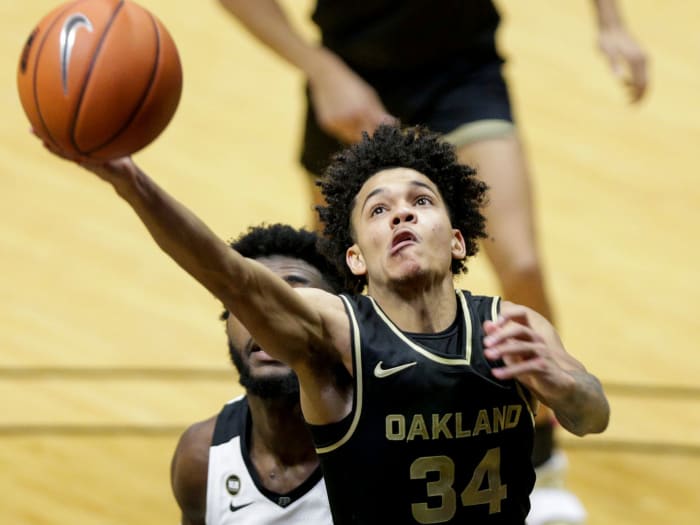
Oakland's Jalen Moore averaged 8.4 assists last season.
Nikos Frazier/Journal & Courier/USA TODAY Network
201. Coastal Carolina (7th in Sun Belt)
202. Hartford (3rd in A-East)
203. La Salle (13th in A-10)
204. UTSA (12th in C-USA)
205. Milwaukee (5th in Horizon)
206. Rider (4th in MAAC)
207. Mercer (6th in SoCon)
208. Prairie View A&M (1st in SWAC)
209. California Baptist (7th in WAC)
210. Robert Morris (6th in Horizon)
211. Northern Colorado (3rd in Big Sky)
212. Nicholls State (1st in Southland)
213. Elon (7th in CAA)
214. Cal State Fullerton (4th in Big West)
215. Southern Miss (13th in C-USA)
216. Montana State (4th in Big Sky)
217. Stetson (5th in A-Sun)
218. Norfolk State (1st in MEAC)
219. Wagner (2nd in NEC)
220. Evansville (10th in MVC)
221. Boston University (2nd in Patriot)
222. Oakland (7th in Horizon)
223. South Dakota (4th in Summit)
224. Marist (5th in MAAC)
225. Central Michigan (9th in MAC)
It’s easy to root for Hartford (No. 202) and head coach John Gallagher, whose reward for the program’s reaching the NCAA tournament for the first time was the school’s announcing plans to move down to D-III. Milwaukee (No. 205) is perhaps the most interesting sub-200 team in the country thanks to the presence of Patrick Baldwin Jr., the five-star recruit and likely NBA lottery pick who’ll play for his dad, Pat, rather than Duke. Color us skeptical he’ll lead the Panthers to Horizon League glory. Mercer (No. 207) has more teeth than your average No. 6 pick in a one-bid league. Neftali Alvarez is an impressive veteran point guard and head coach Greg Gary, a Matt Painter disciple, has an outstanding offensive mind.
Three low-major conference favorites to mention here are Prairie View A&M (No. 208), Nicholls State (No. 212) and Norfolk State (No. 218). At Prairie View, preseason SWAC Player of the Year Jawaun Daniels has quite the story: He spent more than two months on Rikers Island during high school after being caught up in a gang sweep. Nicholls dealt with tragedy this offseason when Louisiana was ravaged by Hurricane Ida, but the Colonels are now back home and closer than ever after relocating to Eastern Kentucky for much of September. And at Norfolk, Robert Jones has won 74% of his MEAC games as the coach of the Spartans and is severely underrated nationally for the job he does there annually.
If you like point guards who can really pass, check out Jalen Moore sometime at Oakland (No. 222). He averaged over eight dimes per game a season ago and got quite the running mate to feed from the portal in former Marquette forward Jamal Cain. Central Michigan (No. 225) has a new coach in former UTEP and Auburn head man Tony Barbee, who most recently spent several years on staff with John Calipari at Kentucky. He’ll have a rebuild on his hands with the Chippewas.
226. Fordham (14th in A-10)
227. Sam Houston State (8th in WAC)
228. Portland State (5th in Big Sky)
229. New Hampshire (4th in A-East)
230. Hawaii (5th in Big West)
231. UIC (8th in Horizon)
232. Monmouth (6th in MAAC)
233. Samford (7th in SoCon)
234. Jackson State (2nd in SWAC)
235. Navy (3rd in Patriot)
236. Morgan State (2nd in MEAC)
237. UC Davis (6th in Big West)
238. LIU (3rd in NEC)
239. VMI (8th in SoCon)
240. UMBC (5th in A-East)
241. Lipscomb (6th in A-Sun)
242. UNC Asheville (3rd in Big South)
243. Kansas City (5th in Summit)
244. Tennessee State (4th in Ohio Valley)
245. Cal State Bakersfield (7th in Big West)
246. Troy (8th in Sun Belt)
247. Montana (6th in Big Sky)
248. UT-Arlington (9th in Sun Belt)
249. Gardner-Webb (4th in Big South)
250. Texas Southern (3rd in SWAC)
Kyle Neptune takes over for Jeff Neubauer at Fordham (No. 226), and the first order of business is improving a, frankly, disastrous offensive situation. Three years ago, New Hampshire (No. 229) embarked on a five-win season. The Wildcats have climbed the America East standings since, and the Jayden Martinez–Nick Guadarrama frontcourt duo figures to give them a chance at the program’s first NCAA tournament trip. Jackson State (No. 234) rode the SWAC’s stingiest defense last season (including ranking first nationally in effective field goal D) to a shared regular-season title. Three starters return, including conference player of the year candidate Jayveous McKinnis.
Morgan State (No. 236) will have one of the nation’s most experienced rosters, headlined by veterans De'Torrion Ware and Malik Miller (It also adds former UNC and South Carolina guard Seventh Woods). The coach who led UMBC (No. 240) to underdog glory, Ryan Odom, took the job at Utah State, and Jim Ferry—coming off the Penn State interim job—takes over in Baltimore. Lipscomb (No. 241) senior Ahsan Asadullah is one of the most underrated centers in the country. Of players 6’ 8” or taller, he ranked third in assist rate (30.6%, per KenPom) and 60th overall last season.
Under Billy Donlon, Kansas City (No. 243) plays at one of the slowest tempos in the country and places a premium on defense and forcing pressure. With three starters gone, the Roos will need to stay consistent on that end to make a push in the Summit. Texas Southern (No. 250) has made three of the last four NCAA tournaments; it will need to overcome the transfer of standout Michael Weathers to make it four of five.
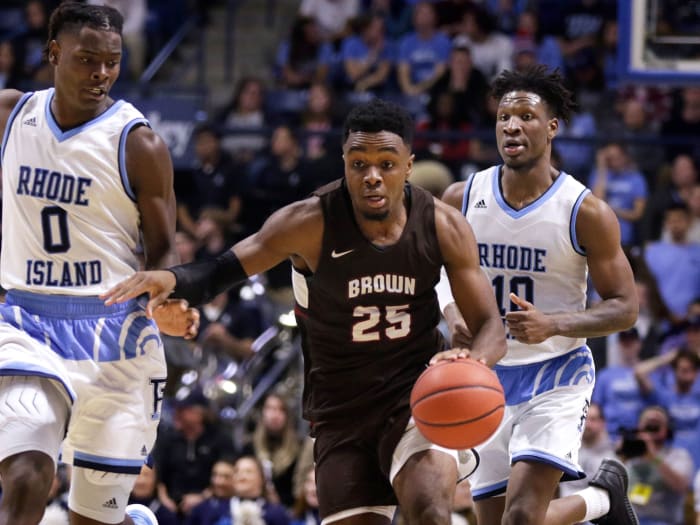
Standout Tamenang Choh is back at Brown after the Ivy League returns from a one-year absence.
Kris Craig/The Providence Journal/USA TODAY Network
251. Brown (5th in Ivy)
252. Georgia Southern (10th in Sun Belt)
253. Longwood (5th in Big South)
254. William & Mary (8th in CAA)
255. Sacred Heart (4th in NEC)
256. Lamar (9th in WAC)
257. Albany (6th in A-East)
258. Long Beach State (8th in Big West)
259. Towson (9th in CAA)
260. Fairfield (7th in MAAC)
261. Louisiana-Monroe (11th in Sun Belt)
262. Army (4th in Patriot)
263. Southeast Missouri State (5th in Ohio Valley)
264. New Orleans (2nd in Southland)
265. Middle Tennessee (14th in C-USA)
266. Youngstown State (9th in Horizon)
267. Jacksonville (7th in A-Sun)
268. Eastern Washington (7th in Big Sky)
269. NC A&T (6th in Big South)
270. UNC Wilmington (10th in CAA)
271. Northern Illinois (10th in MAC)
272. Purdue Fort Wayne (10th in Horizon)
273. Tennessee Tech (6th in Ohio Valley)
274. St. Thomas (6th in Summit)
275. Little Rock (12th in Sun Belt)
Brown (No. 251) got a boost when star forward Tamenang Choh decided to return for his graduate year once the Ivy League green-lit postgraduate players to play in 2021–22 due to last season’s cancellation. Longwood (No. 253) has never made the NCAA tournament since moving to D-I, but transfer additions Isaiah Wilkins (Wake Forest) and Michael Christmas (JMU) give the Lancers a puncher’s chance in the Big South.
New coaches take the reins at Lamar (No. 256) and Albany (No. 257). Lamar Hall of Honor member Alvin Brooks gets another shot at running his own program after assisting Kelvin Sampson at Houston and has a talented backcourt trio of Kasen Harrison, Davion Buster and Jordyn Adams. New Albany coach Dwayne Killings is a high-energy guy who was due for a head job. Transfers De’Vondre Perry and Gerald Drumgoole Jr. should help make the transition a smoother one.
Fairfield’s (No. 260) surprising run to the MAAC title game a season ago could serve as a springboard in a wide-open conference. Speaking of springboards, Middle Tennessee (No. 265) could use one: The Blue Raiders are just 24–62 in three years since Kermit Davis left for Ole Miss, which should heat up Nick McDevitt’s seat entering 2021–22.
Two of the 35 coaches of color hired this spring are Jordan Mincy and Rashon Burno at Jacksonville (No. 267) and Northern Illinois (No. 271), respectively. Both have been deserving of an opportunity like this for multiple years. If you’re looking for a fun story to track this year, how about St. Thomas (No. 275)? The Tommies are the first men’s team in nearly 30 years to jump directly from D-III to D-I, becoming the second D-I program in Minnesota. Coach Johnny Tauer has a PhD in social psychology, is a tenured member of the St. Thomas faculty and runs the Princeton offense.
276. Manhattan (8th in MAAC)
277. Bellarmine (8th in A-Sun)
278. Dartmouth (6th in Ivy)
279. Bucknell (5th in Patriot)
280. Merrimack (5th in NEC)
281. Eastern Michigan (11th in MAC)
282. Mount St. Mary's (6th in NEC)
283. North Carolina Central (3rd in MEAC)
284. Radford (7th in Big South)
285. Austin Peay (7th in Ohio Valley)
286. Portland (10th in WCC)
287. UT Rio Grande Valley (10th in WAC)
288. San Jose State (10th in Mountain West)
289. UMass-Lowell (7th in A-East)
290. Niagara (9th in MAAC)
291. Northern Arizona (8th in Big Sky)
292. Tarleton State (11th in WAC)
293. Quinnipiac (10th in MAAC)
294. Western Michigan (12th in MAC)
295. Grambling State (4th in SWAC)
296. Coppin State (4th in MEAC)
297. St. Francis PA (7th in NEC)
298. Loyola (Md.) (6th in Patriot)
299. North Alabama (9th in A-Sun)
300. Southern (5th in SWAC)
The D-I debut of Bellarmine (No. 277) went quite well, with the Knights winning 10 straight A-Sun games at one point. Their cutting-friendly offense ranked seventh nationally in the half court on a points-per-possession basis (per Synergy Sports), but the momentum may be slowed without leading scorer Pedro Bradshaw. The transfer of NEC title game hero Damian Chong Qui is a tough blow for Mount St. Mary’s (No. 282), but the development of its returning core will determine this team’s ceiling.
Portland (No. 286) has one(!) total WCC win the last three seasons, which earned Terry Porter’s February firing. Shantay Legans arrives from Eastern Washington facing a massive rebuild, and he starts it with a brand-new roster built, in a large way, from the portal. After two years off from the profession, former Nebraska coach Tim Miles has landed at San Jose State (No. 288). He’ll need to work some magic in Year 1 after also filling out his team via transfers—including a handful of additions from the benches of Power 5 programs. Tarleton State (No. 292), another addition to D-I last year (and coached by Billy Gillispie), hopes the return of six of its top seven scorers leads to more consistency as the WAC expands.
Kevin Marfo returns to Quinnipiac (No. 293) after a season spent at Texas A&M. In 2019–20 with the Bobcats, the now-24-year-old’s 13.3 rebounds per game led the country. Without a team offensive turnaround, though, it may be a long year. Coppin State (No. 296) has made strides under Juan Dixon, improving its KenPom final ranking each season. A heavy road schedule threatens to make doing that for a fourth straight year tough. The good news for St. Francis PA (No. 297)? Per T-Rank, 91% of its possession minutes return. The bad news? That group went just 6–16 a season ago—though it did notch a win over Pitt.
301. High Point (8th in Big South)
302. Canisius (11th in MAAC)
303. Presbyterian (9th in Big South)
304. Eastern Illinois (8th in Ohio Valley)
305. North Florida (10th in A-Sun)
306. Fairleigh Dickinson (8th in NEC)
307. Green Bay (11th in Horizon)
308. UC San Diego (9th in Big West)
309. SIU Edwardsville (9th in Ohio Valley)
310. Alabama A&M (6th in SWAC)
311. Holy Cross (7th in Patriot)
312. Sacramento State (9th in Big Sky)
313. Arkansas-Pine Bluff (7th in SWAC)
314. North Dakota (7th in Summit)
315. Southeastern Louisiana (3rd in Southland)
316. Lehigh (8th in Patriot)
317. Cal Poly (10th in Big West)
318. NJIT (8th in A-East)
319. Idaho State (10th in Big Sky)
320. Hampton (10th in Big South)
321. Lafayette (9th in Patriot)
322. The Citadel (9th in SoCon)
323. Columbia (7th in Ivy)
324. McNeese State (4th in Southland)
325. Air Force (11th in Mountain West)
Reggie Witherspoon at Canisius (No. 302) is arguably one of the more influential coaches in the country as the man who brought the continuity ball screen offense to the masses. He might be in for a rough year with the Golden Griffins, though. Longtime Evansville head coach Marty Simmons is back in the game at Eastern Illinois (No. 304), and he’ll rely on a pair of Big Ten transfers in Elijah Wood (Nebraska) and Jermaine Hamlin (Illinois) early in his tenure.
Bo Ryan’s son, Will, is in his second year at the helm at Green Bay (No. 307), but saw his roster gutted by transfers this spring. The loss of leading scorer Amari Davis to Missouri is the most significant one. Holy Cross (No. 311) and star big man Gerrale Gates have to be looking forward to a more normal schedule than last season, when their 16 games came against just four opponents (including six against Boston University). Speaking of scheduling quirks, how about the Southland’s new in-season tournament, featuring Southeastern Louisiana (No. 315)? Every team will play three games against conference foes in early January that will count as nonconference games.
Cal Poly (No. 317) could wind up outperforming this ranking thanks to a very strong transfer class that features former All–Big Sky guard Jacob Davison, high-scoring big Sean Rhea and Oregon State down-transfer Julien Franklin. The Citadel (No. 322) has star power thanks to the return of Hayden Brown, who averaged more than 18 points and 10 rebounds a season ago. One more transfer-heavy group to watch: McNeese State (No. 324), which added TJ Moss (South Carolina), Brendan Medley-Bacon (VCU) and Christian Shumate (Tulsa) among others.
326. St. Francis Brooklyn (9th in NEC)
327. Western Illinois (8th in Summit)
328. Dixie State (12th in WAC)
329. Kennesaw State (11th in A-Sun)
330. Maine (9th in A-East)
331. Idaho (11th in Big Sky)
332. Alcorn State (8th in SWAC)
333. Texas A&M-Corpus Christi (5th in Southland)
334. Omaha (9th in Summit)
335. American (10th in Patriot)
336. USC Upstate (11th in Big South)
337. Cal State Northridge (11th in Big West)
338. IUPUI (12th in Horizon)
339. Cornell (8th in Ivy)
340. Western Carolina (10th in SoCon)
341. Incarnate Word (6th in Southland)
342. UT Martin (10th in Ohio Valley)
343. Binghamton (10th in A-East)
344. Charleston Southern (12th in Big South)
345. Denver (10th in Summit)
346. Northwestern State (7th in Southland)
347. Florida A&M (9th in SWAC)
348. Howard (5th in MEAC)
349. Central Connecticut (10th in NEC)
350. Bethune-Cookman (10th in SWAC)
351. Central Arkansas (12th in A-Sun)
352. Houston Baptist (8th in Southland)
353. Delaware State (6th in MEAC)
354. Alabama State (11th in SWAC)
355. South Carolina State (7th in MEAC)
356. Chicago State (13th in WAC)
357. Mississippi Valley State (12th in SWAC)
358. Maryland-Eastern Shore (8th in MEAC)
Dixie State (No. 328) opens its second year in D-I with a trip to No. 1 Gonzaga, a fellow aficionado of playing fast. Kennesaw State (No. 329) won just two games against D-I foes last season. Can the return of the Owls’ top six scorers bring at least somewhat better days despite an expanded A-Sun? Idaho (No. 331) had a COVID-19 season to forget, going 1–21. Grand Canyon transfer Mikey Dixon leads a litany of newcomers, but this team is probably still ticketed for the Big Sky basement.
Speaking of COVID-19, American (No. 335) was hit hard with interruptions and played just 10 games in 2020–21 … split across four opponents. We’ll see if the Eagles’ strong perimeter shooting in that small sample size can sustain itself. The Ivy League’s pandemic cancellation hit Cornell (No. 338) hard, and multiple impact transfer departures left this roster with precious little starting experience. Incarnate Word (No. 341) shot and defended the three well last year, but had little else to hang its hat on. A shrunken Southland and Oral Roberts transfer RJ Glasper offer potential opportunity.
Makur Maker’s time at Howard (No. 348) lasted all of 47 playing minutes, with the Bison opting out of the season after five games due to the pandemic. They’ll host Notre Dame on Martin Luther King Jr. Day in a spotlight moment for HBCUs. Bethune-Cookman (No. 350) also opted out of 2020–21 and restarts play with an almost entirely new roster.
Mississippi Valley State (No. 357) earned the distinction of having D-I’s least-efficient KenPom offense and defense last season. The Delta Devils earned a majority of their points from behind the arc and improved their perimeter shooting down the stretch, so perhaps there’s reason for a sliver of optimism on that end. Finally, bringing up the rear is UMES (No. 358), another 2020–21 opt out. It retains just two players from its last competitive season.
More College Basketball Coverage:
• 64 Reasons to Be Excited for the CBB Season
• Men's National Player of Year Candidates
• Top Men's Breakout Player Candidates
• Coaches on the Rise Entering 2021–22
